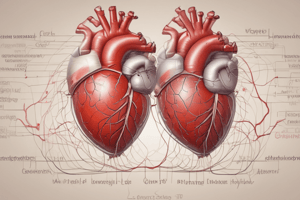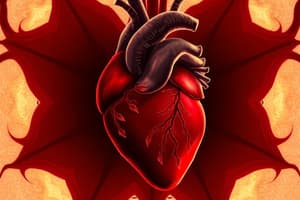Podcast
Questions and Answers
What is the term for the contraction of atria?
What is the term for the contraction of atria?
- Atrial systole (correct)
- Diastole
- Ventricular systole
- AFTERLOAD
Which neurotransmitter is associated with increasing heart rate?
Which neurotransmitter is associated with increasing heart rate?
- Dopamine
- Epinephrine
- Norepinephrine (correct)
- Acetylcholine
What is the function of the SA node in the heart?
What is the function of the SA node in the heart?
- Generating electrical impulses (correct)
- Contracting the ventricles
- Regulating afterload
- Controlling diastole
What is the term for the pressure against which the heart must work to eject blood during systole?
What is the term for the pressure against which the heart must work to eject blood during systole?
What controls the strength and rate of heart contractions?
What controls the strength and rate of heart contractions?
Which of the following neurotransmitters is associated with decreasing heart rate?
Which of the following neurotransmitters is associated with decreasing heart rate?
What is the term for the electrical impulses generated by the heart's natural pacemaker?
What is the term for the electrical impulses generated by the heart's natural pacemaker?
During which phase of the cardiac cycle does neither chamber contract?
During which phase of the cardiac cycle does neither chamber contract?
What is the term for the pressure against which the heart must work to eject blood during systole?
What is the term for the pressure against which the heart must work to eject blood during systole?
What controls the strength and rate of heart contractions?
What controls the strength and rate of heart contractions?
Flashcards are hidden until you start studying
Study Notes
Cardiac Terms and Functions
- The contraction of the atria is known as atrial systole.
- The neurotransmitter responsible for increasing heart rate is norepinephrine.
- The SA node (sinoatrial node) functions as the heart's natural pacemaker, regulating the heart's rhythm by generating electrical impulses.
- The term for the pressure against which the heart must work to eject blood during systole is referred to as afterload.
Heart Rate and Contraction Control
- The strength and rate of heart contractions are controlled by the autonomic nervous system, with input from various neurotransmitters.
- The neurotransmitter associated with decreasing heart rate is acetylcholine.
Cardiac Cycle Phases
- During the diastole phase of the cardiac cycle, neither chamber of the heart contracts, allowing for blood filling.
Studying That Suits You
Use AI to generate personalized quizzes and flashcards to suit your learning preferences.




